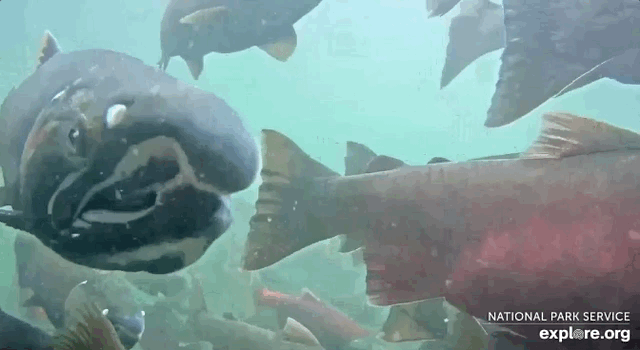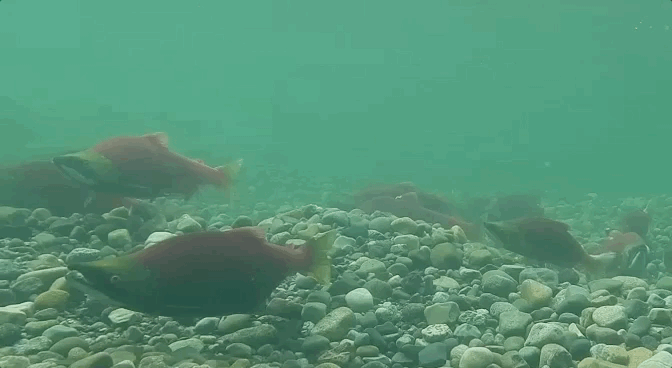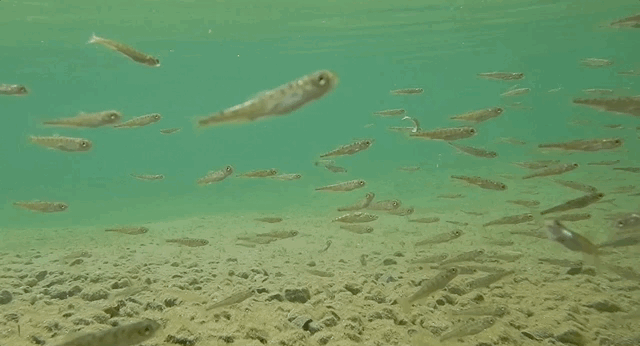Imagine a place where the watershed is un-engineered, where the ecosystem’s productivity and potential is fully realized. It produces half the world’s wild sockeye salmon and is home to more brown bears than people. Then imagine that greed for minerals, driven by mass consumption, threatens it.
Alaska’s Bristol Bay is that place.

Bristol Bay is a 42,000 square mile (1.87 million hectare) watershed that encompasses the southeast corner of the Bering Sea. Ringed by the Kuskokwim Mountains to the north and the Aleutian Range to the south and east, the area is almost wholly undeveloped. The watershed includes two of the nation’s largest national parks (Katmai and Lake Clark), three giant national wildlife refuges (Alaska Peninsula, Becharof, and Togiak), the nation’s largest state park (Wood-Tikchik), as well as millions of acres of undeveloped lands and waters. In short, it is one of the most spectacular and wildest landscapes on the continent.
Wildness, however, doesn’t equate unpeopled. Humans have lived in the Bristol Bay region for at least 9,000 years and likely longer (the oldest human habitation sites were probably flooded by rising sea levels at the end of the last ice age). Bristol Bay’s Yupik, Alutiiq, and Dena’ina developed a complex relationship with the resources they used to survive, especially salmon. Today, salmon remain the cultural, economic, ecological heartbeat of the region.
Born in freshwater and grown large in the sea, salmon are a conveyor of energy and nutrients. Their upriver migration feeds everything from mink, otter, eagles, and brown bears to 30 inch-long rainbow trout and 10-pound char. After spawning, they die and their decomposing bodies distribute millions of pounds of fertilizer, substantially increasing the productivity of an otherwise nutrient poor freshwater system. Salmon even help plants grow faster.
The area’s abundance isn’t fantasy either. Bristol Bay’s 2018 salmon run was the largest on record, with over 62 million wild salmon returning. Of that run, 21 million sockeye went uncaught and escaped upstream to spawn. 2018 was the fourth consecutive year that sockeye salmon runs exceeded 50 million fish. Exvessel value, the activities that occur when a commercial fishing boat lands or unloads a catch, was worth $281 million dollars. In 2010, during a much smaller run compared to 2018, harvesting, processing, and retailing Bristol Bay salmon created $1.5 billion in sales across the U.S. The value of salmon is even higher when all salmon related jobs—fishing, processing, tourism, supplies, services, and government—are taken into account.
Pebble Mine puts all that at risk.

Pebble Mine is a proposed open pit copper and gold mine at the northern headwaters of Bristol Bay. The fully developed mine site would encompass over 8,000 acres. Tailings ponds and an open pit would straddle two incredibly productive salmon producing watersheds—the Kvichak and Nushagak. Supporting infrastructure would include a 270-megawatt power generating plant, a 188-mile natural gas pipeline, dozens of miles of roads, and up to three new ports where no development currently exists.
As part of the required permitting process, the Army Corps of Engineers is currently soliciting comments on its draft Pebble Mine Environmental Impact Statement (DEIS). Comments will be accepted until May 30. I’m working on my comments now and plan to share them in another post, but the draft is huge, over a thousand pages long, so it’s taking me some time to read. However, my initial evaluation of the document has revealed major concerns.
- The DEIS evaluates the mine’s active phase (20 years), but pays little attention to the true lifespan of the mine’s footprint, which will extend for hundreds, even thousands of years and create a permanent hazard to the watershed. After the mine’s proposed 20-year operation phase is complete, the landscape is supposed to be reclaimed. Tailings and waste rock will be stored underground or underwater in the former open pit. The open pit will be allowed to fill with water. Once the open pit lake rises high enough, water would be pumped from it, treated to meet water quality standards, and discharged into the watershed. This must happen forever to prevent groundwater contamination.
- The DEIS does not evaluate the effects of a catastrophic tailings dam failure, which would release a toxic slurry of material into the Kvickchak and Nushagak watersheds. The risk of this is low, but that’s beside the point. The risk still exists and cannot be eliminated.
- The DEIS does not evaluate who will pay for and maintain permanent water treatment in the open pit.* There is currently no financial plan to fund wastewater treatment after the 20-year operational phase when the mine is to be “reclaimed.” Who’s to pick up the tab when the Pebble Partnership, the mining consortium owned by Northern Dynasty Minerals, decides to walk away? The partnership claims financial assurance for site closure and monitoring is required before construction, but this does not assure funding for perpetual waste-water treatment. Since the corporation cannot guarantee financial solvency forever, it should not be allowed to create hazards that last forever.
- The DEIS does not sufficiently evaluate the cultural impact the loss of salmon would represent to local residents, especially Native Alaskans. I’ve never been to any place where a single group of animals means as much to a regional culture as salmon do for the residents of Bristol Bay. For them, loss of salmon would be equivalent to the loss of bison for American Indians across the Great Plains.
- Supporting roads, ports, and other infrastructure have the potential to disrupt some the best, untrammeled bear habitat in the region, especially for bears that use the McNeil River area just north of Katmai National Park.
Pebble’s proponents argue that the mine and salmon can coexist, but the two are at fundamental odds and always will be. Mike Heatwole, president of Public Affairs at the Pebble Partnership, told Mashable that the mine will cause no “population-level challenges to fish and wildlife resources.”

Pebble Partnership also claims the mine isn’t at the headwaters of Bristol Bay, which is blatantly false. This screen shot is taken directly from their website.
Despite talk that the salmon “population” won’t be affected, the mine reduces spawning and rearing habitat no matter what. Even under a best-case scenario where Pebble Partnership keeps its word, this is still precisely how we begin to lose salmon—one impassible culvert, one dam, one mine at a time. A few yards of stream here, a little more there. Does that matter? It sure does, as the story of salmon in the contiguous 48 states illustrates.
When Lewis and Clark explored the lower Columbia, they found the riverbanks lined with people, and a regional subsistence and trade economy based on the river’s salmon. In less than 150 years, it was gone. Farther upstream at Spokane Falls, people once gathered for thousands of years to catch 60 – 80 pound chinook. Those runs too are nothing more than memory.
In Washington State today, we bicker over the last of the wild salmon, considering whether to cull sea lions to help save an endangered population of starving orcas. Not far from where I live, Baker River sockeye are completely dependent on human intervention for their survival, because dams now completely block access to their spawning grounds. The outlook for salmon isn’t good on the rest of the west coast either. By 1999, wild salmon had disappeared from about 40 percent of their historic range in Oregon, Washington, Idaho, and California. Across the continent in Maine, where people have taken great strides to clean up rivers and remove some barriers to salmon migration, almost no wild Atlantic salmon remain. Twelve Atlantic salmon returned to Maine’s second and third largest rivers, the Androscoggin and Kennebec, respectively, in 2018. Twelve.
No single factor caused the collapse of salmon runs in New England or the west coast. It was death by a thousand cuts. They were treated as an afterthought at best, undervalued and willingly sacrificed for “progress.” Similarly, if developed, Pebble Mine probably won’t be the end to salmon in Bristol Bay, but it could certainly be the beginning of the end. As Van Victor, president of the Bristol Bay Economic Development Corporation, rhetorically asked, “At the end of the day, do we really want to risk what is truly one of mother nature’s wonders of the world for copper and gold?”

Young salmon fry feed in one of Bristol Bay untarnished rivers.
If you haven’t seen Bristol Bay, if you haven’t experienced what a truly wild and healthy ecosystem is like, then it might be easy to dismiss my concerns. It can be hard to imagine rivers and streams flooded with fish, where wildlife and people flourish on the seasonal treasure. That dynamic simply no longer exists in most of the rest of North America and we, unfortunately, consider it normal. In conservation biology, this generational amnesia is called shifting baseline syndrome: Every generation sees nature through a different lens and what we view as normal is actually degraded. Our threshold for acceptable environmental conditions is continually being lowered.
Thankfully, we don’t have imagine or scour history books to understand what Bristol Bay’s fishery and ecosystem was once like because it is what it has been since the last of the Ice Age glaciers melted from the landscape. We can still experience it at its full potential. It’s a treasure to savor and protect.
But we could lose it, quite easily in fact. Pebble Mine represents greed over sustainability. If developed, it provides clear evidence we won’t stop till the entire world is consumed. Future generations will judge us poorly if we take everything and leave nothing. It takes a special kind of naiveté to believe otherwise.
*I’d like to add a correction on this point. According to James Fueg of the Pebble Partnership, a closure bond would have to be in place before construction can begin, with the bond’s purpose to fund perpetual wastewater treatment by the state. This is good and something I didn’t know about. However, this is of little consolation. It is unethical for a private corporation to create a permanent hazard that the government then must forever ensure is contained. It’s not in the public’s best interest, and shouldn’t be allowed.
Mike I would like to see your very reasoned comments sent in their entirety to EVERY government official, body, committee, decider, etc. You could not have presented this any clearer. Anyone who reads this who might be sitting on the fence surely must realize the folly, greed and negative consequences of the Pebble mine! Thank you for putting this together and presenting it to ALL.
LikeLike
Thank you Mike!!! Your time and huge efforts to educate all, especially those that haven’t any idea what is being proposed, is very much appreciated!!! I replied in comments at the end before seeing your note to comment above this line. Hope you will still see comments at the end of your post. Judy Thompson
Sent from my iPad
>
LikeLike
Thank you Mike. I am now in the process of writing up my comment and your post mentioned some facts that I missed while doing research on the Pebble Mine. Thank you again for all that you do to help protect our environment and education everyone on matters of importance.
LikeLike
Opps education everyone not education.
LikeLike
Try again – educating
LikeLike
Thank you, Mike.
“Since the corporation cannot guarantee financial solvency forever, it should not be allowed to create hazards that last forever.”
After the willful, vindictive glee in some quarters at seeing nature relegated in favour of a narrower, dirtier industry, the economic shortsightedness is depressingly familiar. Literally handing the bill for any future repercussions arising from this to future generations.
LikeLike
To paraphrase John Muir, nothing dollarable is safe.
I must add a correction to the point you quote, for the sake of fairness. I recently learned a closure bond would have to be in place before construction can begin, with the bond’s purpose to fund perpetual wastewater treatment by the state. This is a positive thing, but it is a small consolation. It is unethical for a private corporation to create a permanent hazard that the government then must forever ensure is contained. It’s not in the public’s best interest and shouldn’t be allowed.
LikeLike
Thanks Mike.
I’m more surprised than encouraged by the presumably finite commitment of funds to cover potentially damaging impacts.
Forever is a conveniently long time to punt such concerns. To a time, I imagine, when profits and taxes have been spent, and corporate, political and personal responsibilities are a memory.
LikeLike
Pingback: My Pebble Mine Draft EIS Comments | Wandering at Large
Pingback: A Victory for Bristol Bay | Wandering at Large